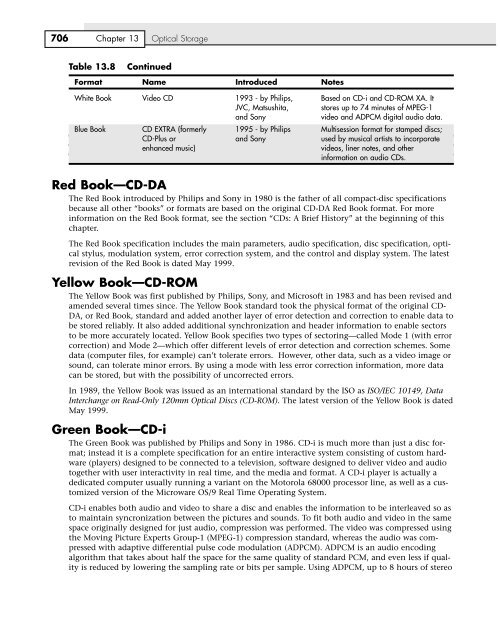Create successful ePaper yourself
Turn your PDF publications into a flip-book with our unique Google optimized e-Paper software.
706 Chapter <strong>13</strong> Optical Storage<br />
Table <strong>13</strong>.8 Continued<br />
Format Name Introduced Notes<br />
White Book Video CD 1993 - by Philips, Based on CD-i and CD-ROM XA. It<br />
JVC, Matsushita, stores up to 74 minutes of MPEG-1<br />
and Sony video and ADPCM digital audio data.<br />
Blue Book CD EXTRA (formerly 1995 - by Philips Multisession format for stamped discs;<br />
CD-Plus or and Sony used by musical artists to incorporate<br />
enhanced music) videos, liner notes, and other<br />
information on audio CDs.<br />
Red Book—CD-DA<br />
The Red Book introduced by Philips and Sony in 1980 is the father of all compact-disc specifications<br />
because all other “books” or formats are based on the original CD-DA Red Book format. For more<br />
information on the Red Book format, see the section “CDs: A Brief History” at the beginning of this<br />
chapter.<br />
The Red Book specification includes the main parameters, audio specification, disc specification, optical<br />
stylus, modulation system, error correction system, and the control and display system. The latest<br />
revision of the Red Book is dated May 1999.<br />
Yellow Book—CD-ROM<br />
The Yellow Book was first published by Philips, Sony, and Microsoft in 1983 and has been revised and<br />
amended several times since. The Yellow Book standard took the physical format of the original CD-<br />
DA, or Red Book, standard and added another layer of error detection and correction to enable data to<br />
be stored reliably. It also added additional synchronization and header information to enable sectors<br />
to be more accurately located. Yellow Book specifies two types of sectoring—called Mode 1 (with error<br />
correction) and Mode 2—which offer different levels of error detection and correction schemes. Some<br />
data (computer files, for example) can’t tolerate errors. However, other data, such as a video image or<br />
sound, can tolerate minor errors. By using a mode with less error correction information, more data<br />
can be stored, but with the possibility of uncorrected errors.<br />
In 1989, the Yellow Book was issued as an international standard by the ISO as ISO/IEC 10149, Data<br />
Interchange on Read-Only 120mm Optical Discs (CD-ROM). The latest version of the Yellow Book is dated<br />
May 1999.<br />
Green Book—CD-i<br />
The Green Book was published by Philips and Sony in 1986. CD-i is much more than just a disc format;<br />
instead it is a complete specification for an entire interactive system consisting of custom hardware<br />
(players) designed to be connected to a television, software designed to deliver video and audio<br />
together with user interactivity in real time, and the media and format. A CD-i player is actually a<br />
dedicated computer usually running a variant on the Motorola 68000 processor line, as well as a customized<br />
version of the Microware OS/9 Real Time Operating System.<br />
CD-i enables both audio and video to share a disc and enables the information to be interleaved so as<br />
to maintain syncronization between the pictures and sounds. To fit both audio and video in the same<br />
space originally designed for just audio, compression was performed. The video was compressed using<br />
the Moving Picture Experts Group-1 (MPEG-1) compression standard, whereas the audio was compressed<br />
with adaptive differential pulse code modulation (ADPCM). ADPCM is an audio encoding<br />
algorithm that takes about half the space for the same quality of standard PCM, and even less if quality<br />
is reduced by lowering the sampling rate or bits per sample. Using ADPCM, up to 8 hours of stereo
















